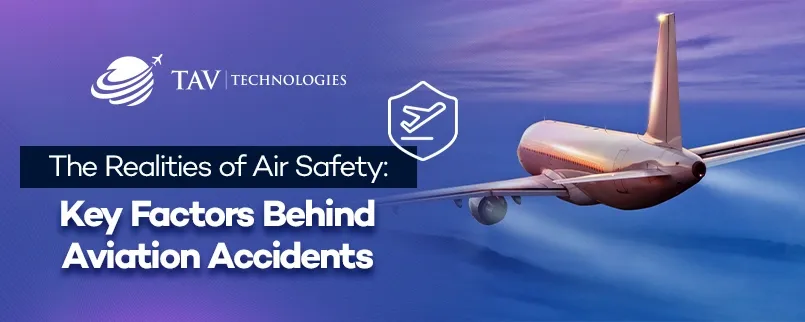
Jan 2025
Air travel is one of the safest modes of transportation, but when accidents occur, they remind us of the complexities involved in aviation safety. Each incident serves as a critical lesson for the industry, highlighting areas for improvement and reinforcing the importance of rigorous safety measures. This blog explores the common causes of air accidents and the steps taken to minimize these risks, ensuring a safer future for all who take to the skies.
Common Causes of Air Accidents
Although aviation accidents do not occur frequently, we have suffered tragic losses over the years. So, what were the main causes of these accidents? Here you can find some of the reasons of accidents:
1. Pilot Error
Human error remains a leading cause of air accidents. Mistakes can result from judgment lapses, failure to follow procedures, miscommunication, or inadequate responses to unexpected situations. Despite rigorous training, factors such as fatigue, stress, or inexperience can play a role. To address this, the aviation industry has continuously improved pilot training programs and introduced advanced cockpit technologies designed to reduce the margin for error.
2. Mechanical Failure
Aircraft are incredibly complex machines with thousands of moving parts. Mechanical failure, while rare due to rigorous maintenance schedules, is still a factor in some crashes. Issues like engine failure, structural problems, or malfunctioning avionics can lead to accidents if not properly addressed.
3. Weather Conditions
Severe weather is another major contributor to plane crashes. Conditions such as thunderstorms, strong winds, low visibility, and icing can all pose risks to aircraft. Pilots are trained to handle many weather-related situations, but sudden and unexpected changes can still create hazardous situations, especially in poor weather forecasting or when flying through stormy areas at high altitudes.
4. Bird Strikes
Collisions with birds, known as bird strikes, are a common risk for aircraft, especially during takeoff and landing. These strikes can cause significant damage to engines, windshields, and other parts of the aircraft. While most bird strikes result in little damage, they have been the cause of some major accidents in history.
5. Air Traffic Control Errors
While air traffic controllers are highly trained, mistakes can occasionally happen due to communication breakdowns, misinterpretation of flight plans, or errors in coordinating air traffic.
These errors can lead to dangerous situations, such as near misses, collisions, or misdirected flights.
6. Sabotage or Terrorism
Although rare, deliberate acts of sabotage or terrorism can result in catastrophic plane crashes. These events are usually intentional and involve criminal acts such as bombings or hijackings. Airlines and airports have significantly increased security measures to prevent such incidents.
7. Maintenance Errors
Improper or inadequate maintenance is another factor that can contribute to accidents. Aircraft undergo routine inspections and maintenance to ensure their safety, but errors in the process, whether due to human oversight or faulty procedures, can result in dangerous situations. Ensuring proper maintenance checks and records is crucial to preventing these accidents.
8. Technological Failures
Although technology has significantly improved aviation safety, it can also be a contributing factor to crashes if systems fail. These can range from issues with flight management systems to communication malfunctions or software bugs. Ongoing advancements in aircraft technology, including automation and artificial intelligence, aim to reduce the risk of such failures.
Lessons Learned and Future Directions
The aviation industry learns from every incident, using the findings to strengthen safety protocols and innovate solutions. Some key areas of focus include:
· AI-Driven Predictive Maintenance: The implementation of artificial intelligence (AI) systems to predict and prevent mechanical failures before they occur became more widespread, enabling proactive repairs and reducing the risk of in-flight incidents.
· Enhanced Pilot Training: Training programs were further enhanced, with a focus on decision-making skills, managing high-pressure situations, and reacting to unexpected events. Simulations of complex flight scenarios were introduced to improve pilot preparedness.
· Improved Weather Prediction: The development of more accurate and robust weather prediction tools helped airlines and air traffic controllers anticipate dangerous weather conditions, allowing for safer flight planning and execution.
Air travel continues to evolve with safety as its cornerstone. By understanding the causes of air accidents and addressing these risks proactively, the aviation industry ensures that passengers can travel with confidence. Ongoing advancements in technology, training, and infrastructure reflect a shared commitment to making the skies safer for everyone.
In examining the causes of air accidents and the responses to them, stakeholders across the aviation industry continue to prioritize safety, ensuring that passengers can confidently trust in the future of air travel.
